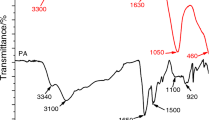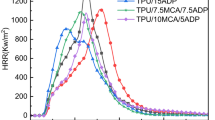Abstract
In the present study, the effect of the aluminum hypophosphite (AlHP) concentration on the flame retardant properties of the four different polymers [polyamide 6 (PA6), poly(lactic acid) PLA, thermoplastic polyurethane (TPU) and poly(methyl methacrylate) (PMMA)] was investigated through mass loss calorimeter tests (MLC), thermogravimetric analysis, limiting oxygen index (LOI) and vertical burning test (UL-94). Test results from UL-94 test revealed that 20 wt% AlHP was needed to reach V0 rating in the PA6, TPU and PMMA and 10 wt% was required for PLA. LOI values and the char yields of all composites were increased with increasing AlHP amount. However, peak heat release (pHRR) and total heat evolved values decreased as the added amount of AlHP increased. The highest LOI value (31) and the lowest pHRR value (134 kW/m2) were obtained in TPU/30 AlHP composites. In brief, the comprehensive test results showed that the incorporation of the AlHP improved the flame retardant properties of the PA6, PLA, TPU and PMMA via the formation of the char in the condensed phase and radical trapping and dilution effect in the gas phase.






Similar content being viewed by others
References
Dasari A, Yu Z, Cai G, Mai Y (2013) Recent developments in the fire retardancy of polymeric materials. Prog Polym Sci 38:1357–1387. https://doi.org/10.1016/j.progpolymsci.2013.06.006
Laoutid F, Bonnaud L, Alexandre M, Lopez-Cuesta J, Dubois Ph (2009) New prospects in flame retardant polymer materials: from fundamentals to nanocomposites. Mater Sci Eng R Rep 63:100–125. https://doi.org/10.1016/j.mser.2008.09.002
Morgan A, Gilman J (2013) An overview of flame retardancy of polymeric materials: application, technology, and future directions. Fire Mater 37:259–279. https://doi.org/10.1002/fam.2128
Chen X, Ma C, Jiao C (2016) Synergistic effect between [Emim] PF6 and aluminum hypophosphite on flame retardant thermoplastic polyurethane. RSC Adv 6:67409–67417. https://doi.org/10.1039/C6RA14094G
Zhao B, Chen L, Long J, Jian R, Wang Y (2013) Synergistic effect between aluminum hypophosphite and alkyl-substituted phosphinate in flame-retarded polyamide 6. Ind Eng Chem Res 52:17162–17170. https://doi.org/10.1021/ie4009056
Chen X, Ma C, Jiao C (2016) Enhancement of flame-retardant performance of thermoplastic polyurethane with the incorporation of aluminum hypophosphite and iron-graphene. Polym Degrad Stab 129:275–285. https://doi.org/10.1016/j.polymdegradstab.2016.04.017
Jian RK, Chen L, Zhao B, Yan YW, Li XF, Wang YZ (2014) Acrylonitrile–butadiene–styrene terpolymer with metal hypophosphite: flame retardance and mechanism research. Ind Eng Chem Res 53:2299–2307. https://doi.org/10.1021/ie403726m
Tang G, Wang X, Xing W, Zhang P, Wang B, Hong N, Yang W, Hu Y, Song L (2012) Thermal degradation and flame retardance of biobased polylactide composites based on aluminum hypophosphite. Ind Eng Chem Res 51:12009–12016. https://doi.org/10.1021/ie3008133
Li Q, Li B, Zhang S, Lin M (2012) Investigation on effect of aluminum and magnesium hypophosphites on flame retardancy and thermal degradation of polyamide 6. J Appl Polym Sci 125:1782–1789. https://doi.org/10.1002/app.35678
Pan Y, Hong N, Zhan J, Wang B, Song L, Hu Y (2014) Effect of graphene on the fire and mechanical performances of glass fiber-reinforced polyamide 6 composites containing aluminum hypophosphite. Polym Plast Technol and Eng 53:1467–1475. https://doi.org/10.1080/03602559.2014.909483
Lin Y, Jiang S, Hu Y, Chen G, Shi X, Peng X (2018) Hybrids of aluminum hypophosphite and ammonium polyphosphate: highly effective flame retardant system for unsaturated polyester resin. Polym Compos 39:1763–1770. https://doi.org/10.1002/pc.24128
Xiao X, Hu S, Zhai J, Chen T, Mai Y (2016) Thermal properties and combustion behaviors of flame-retarded glass fiber-reinforced polyamide 6 with piperazine pyrophosphate and aluminum hypophosphite. J Therm Anal Calorim 125:175–185. https://doi.org/10.1007/s10973-016-5391-0
Zhou X, Li J, Wu Y (2015) Synergistic effect of aluminum hypophosphite and intumescent flame retardants in polylactide. Polym Adv Technol 26:255–265. https://doi.org/10.1002/pat.3451
Xiao S, Chen M, Dong L, Deng C, Chen L, Wang Y (2014) Thermal degradation, flame retardance and mechanical properties of thermoplastic polyurethane composites based on aluminum hypophosphite. Chin J Polym Sci 32:98–107. https://doi.org/10.1007/s10118-014-1378-0
Shi Y, Fu L, Chen X, Guo J, Yang F, Wang J, Zheng Y, Hu Y (2017) Hypophosphite/graphitic carbon nitride hybrids: preparation and flame-retardant application in thermoplastic polyurethane. Nanomaterials 7:259–272. https://doi.org/10.3390/nano7090259
Zhao B, Chen L, Wang Y (2012) Thermal degradation and fire behaviors of glass fiber reinforced PA6 flame retarded by combination of aluminum hypophosphite with melamine derivatives. In: Morgan AB, Wilkie CA, Nelson GL (eds) Fire and polymers VI: new advances in flame retardant chemistry and science, vol 1118. ACS symposium series. American Chemical Society, Washington, pp 168–182. https://doi.org/10.1021/bk-2012-1118.ch012
Liu G, Gao S (2018) Synergistic effect between aluminum hypophosphite and a new intumescent flame retardant system in poly(lactic acid). J Appl Polym Sci 135:46359–46368. https://doi.org/10.1002/app.46359
Tang G, Zhang R, Wang X, Wang B, Song L, Hu Y, Gong X (2013) Enhancement of flame retardant performance of bio-based polylactic acid composites with the incorporation of aluminum hypophosphite and expanded graphite. J Macromol Sci A 50:255–269. https://doi.org/10.1080/10601325.2013.742835
Zhu ZM, Rao WH, Kang AH, Liao W, Wang YZ (2018) Highly effective flame retarded polystyrene by synergistic effects between expandable graphite and aluminum hypophosphite. Polym Degrad Stab 154:1–9. https://doi.org/10.1016/j.polymdegradstab.2018.05.015
Wu W, Lv S, Li X, Qu H, Zhang H, Xu J (2014) Using TG–FTIR and TG–MS to study thermal degradation of metal hypophosphites. J Therm Anal Calorim 118:1569–1575. https://doi.org/10.1007/s10973-014-4085-8
Aoyagi Y, Yamashita K, Doi Y (2002) Thermal degradation of poly[(R)-3-hydroxybutyrate], poly [Ɛ-caprolactone], and poly[(S)-lactide]. Polym Degrad Stab 76:53–59. https://doi.org/10.1016/S0141-3910(01)00265-8
Isıtman N, Kaynak C (2010) Nanoclay and carbon nanotubes as potential synergistic of an organophosphorus flame-retardant in poly(methyl methacrylate). Polym Degrad Stab 95:1523–1532. https://doi.org/10.1016/j.polymdegradstab.2010.06.013
Manring LE (1991) Thermal degradation of poly(methyl methacrylate). 4. Random side group scission. Macromolecules 24:3304–3309. https://doi.org/10.1021/ma00011a040
He J, Cai G, Wilkie CA (2014) The effects of several sulfonates on thermal and fire retardant properties of poly(methyl methacrylate) and polystyrene. Polym Adv Technol 25:160–167. https://doi.org/10.1002/pat.3217
Laachachi A, Ferriol M, Cochez M, Cuesta JML, Ruch D (2009) A comparison of the role of boehmite (AlOOH) and alumina (Al2O3) in the thermal stability and flammability of poly(methyl methacrylate). Polym Degrad Stab 94:1373–1378. https://doi.org/10.1016/j.polymdegradstab.2009.05.014
Cinausero N, Azema N, Cuesta JML, Cochez M, Ferriol M (2011) Impact of modified alumina oxides on the fire properties of PMMA and PS nanocomposites. Polym Adv Technol 22:1931–1939
Jiang S, Yang H, Qian X, Shi Y, Zhou K, Xu H, Shan X, Lo S, Hu Y, Gui Z (2014) A novel transparent cross-linked poly(methyl methacrylate) based copolymer with enhanced mechanical, thermal and flame retardant properties. Ind Eng Chem Res 53:2880–3887. https://doi.org/10.1021/ie4035863
Cinausero N, Azema N, Lopez-Cuesta JM, Cochez M, Ferriol M (2011) Synergistic effect between hydrophobic oxide nanoparticles and ammonium polyphosphate on fire properties of poly(methyl methacrylate) and polystyrene. Polym Degrad Stab 96:1445–1454. https://doi.org/10.1016/j.polymdegradstab.2011.05.008
Huang G, Guo H, Yang J, Wang X, Gao J (2013) Effect of phosphorus-nitrogen containing quaternary ammonium salt structure on the flammability properties of poly(methyl methacrylate)/montmorillonite nanocomposites. Ind Eng Chem Res 52:4089–4097
Schartel B (2010) Phosphorus-based flame retardancy mechanisms—old hat or a starting point for future development? Materials 3:4710–4745. https://doi.org/10.3390/ma3104710
Lu SY, Hamerton I (2002) Recent developments in the chemistry of halogen-free flame retardant polymers. Prog Polym Sci 27:1661–1712. https://doi.org/10.1016/S0079-6700(02)00018-7
Schartel B, Hull TR (2007) Development of fire-retardant materials—interpretation of cone calorimeter data. Fire Mater 31:327–354. https://doi.org/10.1002/fam.949
Qi Y, Wu W, Liu X, Qu H, Xu J (2017) Preparation and characterization of aluminum hypophosphite/reduced graphene oxide hybrid material as a flame retardant additive for PBT. Fire Mater 41:195–208. https://doi.org/10.1002/fam.2382
Yang W, Song L, Hu Y (2013) Comparative study on thermal decomposition and combustion behavior of glass-fiber reinforced poly (1,4-butylene terephthalate) composites containing trivalent metal (Al, La, Ce) hypophosphite. Polym Compos 34:1832–1839. https://doi.org/10.1002/pc.22588
Yuan B, Bao C, Guo Y, Song L, Liew KM, Hu Y (2012) Preparation and characterization of flame retardant aluminum hypophosphite/poly (vinyl alcohol) composite. Ind Eng Chem Res 51:14065–14075. https://doi.org/10.1021/ie301650f
Messerschmidt B, Hees PV (2002) Influence of delay times and response times on heat release measurements. Fire Mater 26:191–199. https://doi.org/10.1002/1099-1018(200003/04)24:2%3c121:AID-FAM732%3e3.0.CO;2-K
Sponton M, Ronda JC, Galia M, Cadiz V (2009) Cone calorimetry studies of benzoxazine–epoxy systems flame retarded by chemically bonded phosphorus or silicon. Polym Degrad Stab 94:102–106. https://doi.org/10.1016/j.polymdegradstab.2008.10.005
Acknowledgements
This work is supported by Erciyes University Scientific Research Unit under Grant No. BAP-FDK-2016-6288.
Author information
Authors and Affiliations
Corresponding author
Additional information
Publisher's Note
Springer Nature remains neutral with regard to jurisdictional claims in published maps and institutional affiliations.
Rights and permissions
About this article
Cite this article
Savas, L.A., Hacioglu, F., Hancer, M. et al. Flame retardant effect of aluminum hypophosphite in heteroatom-containing polymers. Polym. Bull. 77, 291–306 (2020). https://doi.org/10.1007/s00289-019-02746-7
Received:
Revised:
Accepted:
Published:
Issue Date:
DOI: https://doi.org/10.1007/s00289-019-02746-7




